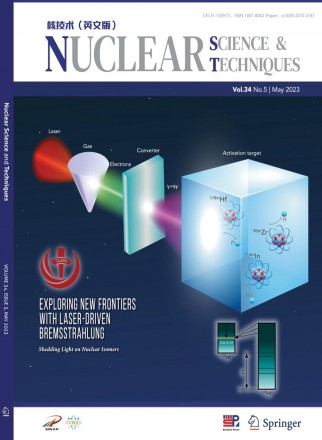
《Nuclear Science and Techniques期刊》SCI期刊 CSCD期刊 统计源期刊
Nuclear Science and Techniques《Nuclear Science and Techniques》杂志是SCI期刊CSCD期刊、统计源期刊、,创办于1990年,发行周期是双月刊。综合影响因子0.25,中国核学会;中国科学院上海原子核研究所主办,中国科学院主管。主要栏目有同步辐射技术及应用、低能加速器技术、射线技术及应用、核化学、放射化学、放射性药物和核医学、核电子学与仪器、核物理与交叉学科研究、核能科学与工程、等
-
主管单位:中国科学院
-
ISSN:1001-8042
-
主办单位:中国核学会;中国科学院上海原子核研究所
-
CN:31-1559/TL
-
审核时间:1-3个月
-
创刊时间:1990
-
全年订价:¥ 672.00
-
发行周期:双月刊
咨询电话:400-838-9661
杂志简介
《Nuclear Science and Techniques》创刊于1989年,邮发代码:4-647,由中国科学院上海应用物理研究所;中国核学会主办。上海市核学会协办都的综合性学术期刊。
《Nuclear Science and Techniques》旨在通过介绍国内外最新核科技成果,反映当前中国核科学技术发展的动向和学术水平。主要方向为同步辐射技术及应用、低能加速器技术、射线技术及应用、核化学、放射化学、放射性药物和核医学、核电子学与仪器、核物理与交叉学科研究、核能科学与工程等。本刊被SCI-E、CA、SA、CSCD等数据库收录。
《Nuclear Science and Techniques》是中国核学会会刊,由国内外核研究领域的著名科学家组成编委会。它刊登理论、实验和应用核物理,放射化学和辐射化学,核测量方法和仪器,核能与石材料科学、生命科学、农业、地球和环境科学方面的应用,是中国在核研究领域中唯一的一份英文期刊。发表的论文为国际六大著名检索期刊中的五个所收录。
期刊须知
1.Title: Titles should be no more than three typeset lines (generally 135 characters including spaces) and should be comprehensible to a broad scientific audience.
2.Author affiliation: Include department, institution, and complete address, with the ZIP/postal code, for each author. Use superscripts to match authors with institutions.
3.Corresponding author: The name, complete address, telephone number, and e-mail address of the author to whom correspondence and proofs should be sent. E-mail addresses will appear in print and online.
4.Body of the paper, including abstract, keywords, introduction, experimental section, results and discussion, conclusion, acknowledgement and references.
5.Abstract: Provide an abstract of no more than 200 words. Abstracts should provide a succinct, informative summation of the most important results and conclusions.
6.Key words: Keywords are listed below the abstract of the manuscript. At least three keywords are required at submission.
7.Introduction: The Introduction should provide a statement outlining the motivation for the research and should accurately place the investigations in context with previous or current work in the field.
8.Experimental Section: The Experimental Section should provide a clear, unambiguous description of materials, methods, and equipment in sufficient detail to permit repetition of the work elsewhere. Repetitive descriptions of a general procedure should be avoided.
9.Results and Discussion: These sections should present the results, and their interpretation, in context with existing knowledge in a clear and concise manner.
10.Conclusion: A conclusion section should be provided in instances where the key elements of the results and discussion may require amplification or clarification. This section should not simply restate the Abstract.
11.Acknowledgments: List acknowledgments.
12.References: References must be in NST style. Only published or in-press papers and books may be cited in the reference list. Unpublished abstracts of papers presented at meetings or references to ‘‘data not shown’’ are not permitted. Each literature reference should be assigned one number and placed in the text as a superscript numeral.
期刊收录
数据分析
- 综合影响因子:0.92
- 期刊他引率:暂无
- 被引半衰期:暂无
- 平均引文率:暂无
立即指数
期刊他引率
立即指数:表征期刊即时反应速率的指标,即该期刊在评价当年刊载的论文,每篇被引用的平均次数。
期刊他引率:期刊被他刊引用的次数占该刊总被 引次数的比例用以测度某期刊学术交流的广度、专业面的宽窄以及学科的交叉程度。
影响因子:指该刊在某年被全部源刊物引证该刊前两年发表论文的次数,与该刊前两年所发表的全部源论文数之比。
影响因子
杂志发文量
主要发文机构分析
| 机构名称 | 发文量 | 主要研究主题 |
| - | - | - |
相关杂志
-
Journal of Thermal Sci...
主管单位:中国科学院
-
Journal of Wuhan Unive...
主管单位:国家教育部
-
Journal of Systems Sci...
主管单位:中国科学技术协会
-
Science China Mathemat...
主管单位:中国科学院
-
Journal of Computer Sc...
主管单位:中国科学院
-
Science China Technolo...
主管单位:中国科学院
-
Plasma Science and Tec...
主管单位:中国科学院;中国科协
-
Science China Earth Sc...
主管单位:中国科学院
-
International Journal ...
主管单位:中华人民共和国教育部
-
Chinese Journal of Pol...
主管单位:中国科学技术协会
-
Journal of Materials S...
主管单位:中国科协
-
Water Science and Engi...
主管单位:中华人民共和国教育部
免责声明
若用户需要出版服务,请联系出版商,地址:上海市800-204信箱 联合编辑部,邮编:201800。